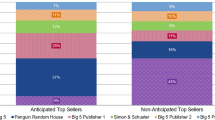Abstract
This paper suggests an innovative measure of structural relief obtained in a typical Section 7 settlement. The fraction of competitive overlap subject to divestiture as a condition of the settlement is modeled as a function of merger-specific efficiencies, the proportion of the deal held “hostage” to antitrust review, the merger’s anticompetitive potential, and other factors. The model is applied to data on 86 recent Justice Department cases covering the period 1990–2003 and to the subsample of 1990s cases. All data are collected from publicly available documents only. The government is found to secure larger divestitures when the cost to the acquirer of delaying the settlement is high. The resulting estimates are used to predict several out-of-sample observations.
Similar content being viewed by others
References
Audretsch D.A. (1983) The Effectiveness of Antitrust Policy towards Horizontal Mergers. UMI Research Press, Ann Arbor, MI
Baer W.J., Redcay R.C. (2001) ‘Solving Competition Problems in Merger Control: The Requirements for an Effective Divestiture Remedy, Symposium: Pyrrhic Victories? Reexamining the Effectiveness of Antitrust Remedies in Restoring Competition and Deterring Misconduct’. George Washington University Law Review 69:915–931
Blumenthal W. (2001) ‘Reconciling the Debate over Merger Remedies: a Discussant’s Proposed Decision Rule, Symposium: Pyrrhic Victories? Reexamining the Effectiveness of Antitrust Remedies in Restoring Competition and Deterring Misconduct’. George Washington University Law Review 69:978–995
Coate M.B. (1992) ‘Economics, the Guidelines and the Evolution of Merger Policy’. Antitrust Bulletin 37:997–1024
Coate M.B. (1995a) ‘The Shifting Sands of Merger Enforcement at the Federal Trade Commission’. International Journal of the Economics of Business 2:393–408
Coate, M. B. (1995b) ‘Merger Analysis in the Courts, Managerial and Decision Economics’, 16, 581–592.
Coate M.B. (2000) ‘Merger Enforcement at the Federal Trade Commission in Three Presidential Administrations’. Antitrust Bulletin 45:323–347
Coate M.B. (2005) ‘Empirical Analysis of Merger Enforcement Under the 1992 Merger Guidelines’. Review of Industrial Organization 27:279–301
Coate M.B., Higgins R., McChesney F. (1990) ‘Bureaucracy and Politics in FTC Merger Challenges’. Journal of Law and Economics 33:463–482
Coate M.B., Kleit A.N. (2004) ‘The Art of the Deal: The Merger Settlement Process at the Federal Trade Commission’. Southern Economic Journal 70:977–997
Coate M.B., Kleit A., Bustamante R. (1995) ‘Fight, Fold or Settle?: Modeling the Reaction to FTC Merger Challenges’. Economic Inquiry 33:237–251
Coate M.B., McChesney F.S. (1992) ‘Empirical Evidence on FTC Enforcement of the Merger Guidelines’. Economic Inquiry 30:277–293
Coate, M. B. and S. W. Ulrick (2005) Transparency at the Federal Trade Commission: The Horizontal Merger Review Process, 1996–2003, Federal Trade Commission, Economic Isuues Paper at http://www.ftc.gov/os/2005/02/0502economicissues.pdf
Eckbo B.E. (1992) ‘Mergers and the Value of Antitrust Deterrence’. Journal of Finance 47:1005–1029
Elzinga K.G. (1969) ‘The Antimerger Law: Pyrrhic Victories?’. Journal of Law and Economics 12:43–78
Federal Trade Commission (FTC) (1999) A Study of the Commission’s Divestiture Process. Online at http://www.ftc.gov/os/1999/9908/divestiture.pdf
Johnson R.N., Parkman A.M. (1991) ‘Premerger Notification and the Incentive to Merge and Litigate’. Journal of Law, Economics, and Organization 7:145–162
Katz M.L. (2002) ‘Recent Antitrust Enforcement Actions by the U.S. Department of Justice: A Selective Survey of Economic Issues’. Review of Industrial Organization 21:373–397
Kouliavtsev M.S. (2003) Antimerger Relief: Theory and Evidence. Ph.D. Dissertation, Temple University, Philadelphia, PA
Kouliavtsev M.S. (2005) ‘Some Empirical Evidence on the Effectiveness of Antimerger Relief in the United States’. Economic Inquiry 43:370–384
Lopatka J.E., Mongoven J.F. (1995) ‘After Preliminary Relief in Merger Cases is Denied, What Then?’. Research in Law and Economics 17:149–224
Limdep, ver. 7.0. Econometric Software, Inc., Plainview, NY.
Muthoo A. (1999) Bargaining Theory with Applications. Cambridge University Press, Cambridge, UK
Pagan A., Vella F. (1989) ‘Diagnostic Tests for Models Based on Individual Data: A Survey’. Journal of Applied Econometrics 4:S29–S59
Parker, R. G. and D. A. Balto (2000) The Evolving Approach to Merger Remedies. Speech, published in Antitrust Report, May, 2–28
Pfunder M., Plaine D., Whittemore A.M. (1972) ‘Compliance with Divestiture Orders Under Section VII of the Clayton Act: An Analysis of the Relief Obtained’. Antitrust Bulletin 17:19–180
Rogowsky R.A (1982) An Economic Study of Antimerger Remedies. Ph.D. Dissertation, University of Virginia, Charlottesville, VA
Rogowsky R.A. (1986) ‘The Economic Effectiveness of Section VII Relief’. Antitrust Bulletin 31:187–233
Ryan, J. H. (2000) Politics and Business Cycles: Determinants of Merger Enforcement at the Federal Trade Commission under the Hart–Scott–Rodino Act. Ph.D. Dissertation, Capella University.
Scheffman, D., M. Coate, and L. Silvia (2002) Twenty Years of Merger Guidelines Enforcement at the FTC: An Economic Perspective. Paper prepared for the 20th Anniversary of the 1982 Merger Guidelines. Washington, D.C.: FTC. Online: http://www.usdoj.gov/atr/hmerger/11255.htm
Scheffman D., Coleman M. (2002) ‘Current Economic Issues at the FTC’. Review of Industrial Organization 21:357–371
Sims J., McFalls M. (2001) ‘Negotiated Merger Remedies: How Well Do They Solve Competition Problems? Symposium: Pyrrhic Victories? Reexamining the Effectiveness of Antitrust Remedies in Restoring Competition and Deterring Misconduct’. George Washington University Law Review 69:932–951
Tremblay V.J. (1993) ‘Consistency Between the Law and Its Enforcement: The Case of Mergers’. Antitrust Bulletin 38:327–348
Triggs, C. (2002) ‘FTC Divestiture Policy’. Antitrust, Fall, 75–79
Winston C., Crandall R.W. (2003) ‘Does Antitrust Policy Improve Consumer Welfare? Assessing the Evidence’. Journal of Economic 17:3–26
Author information
Authors and Affiliations
Corresponding author
Additional information
I would like to thank the General Editor and two anonymous referees for many helpful suggestions on earlier drafts of this paper. The remaining errors are mine.
Rights and permissions
About this article
Cite this article
Kouliavtsev, M.S. Measuring the Extent of Structural Remedy in Section 7 Settlements: Was the US DOJ Successful in the 1990s?. Rev Ind Organ 30, 1–27 (2007). https://doi.org/10.1007/s11151-006-9118-4
Published:
Issue Date:
DOI: https://doi.org/10.1007/s11151-006-9118-4



